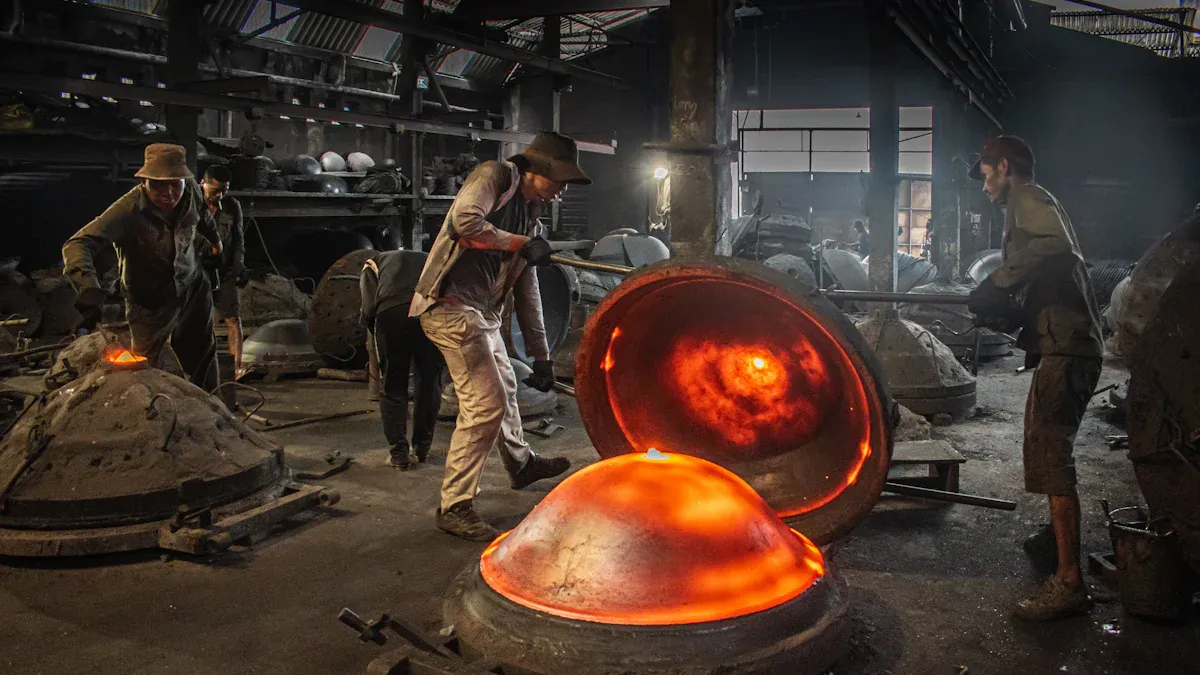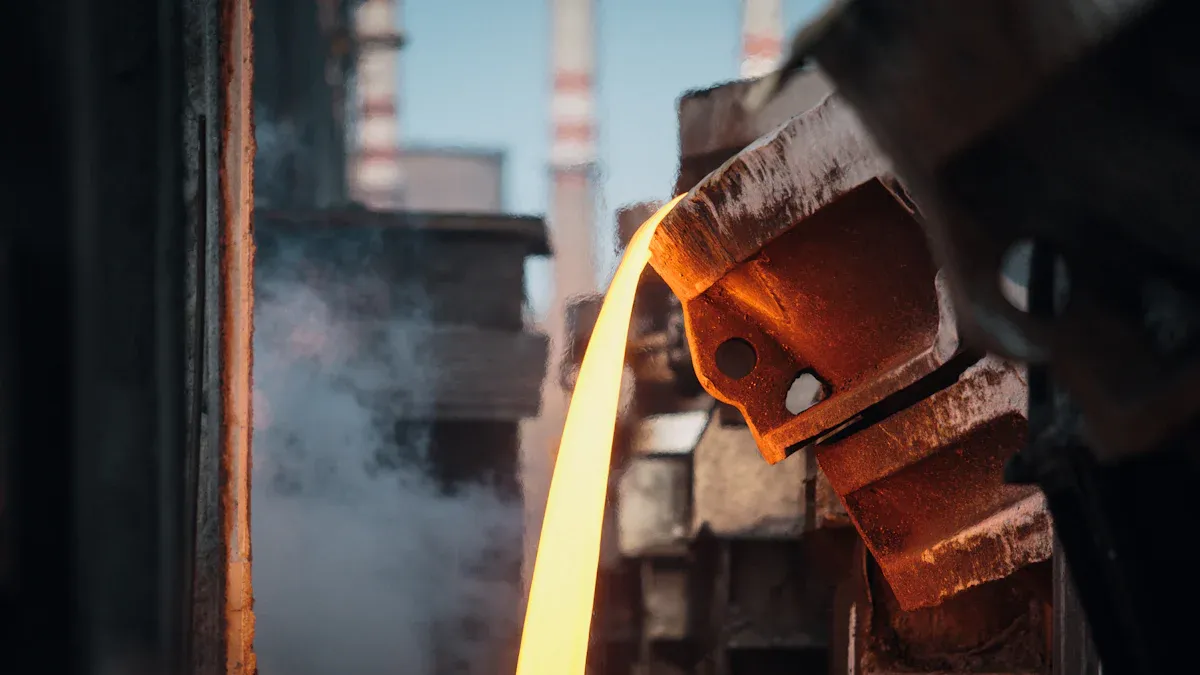
Thin wall investment casting is a precision manufacturing process that creates lightweight, high-strength components with remarkable accuracy. This method, known for its precision castings, is essential in industries like aerospace and construction, where intricate parts are produced to reduce weight while maintaining durability. The precision investment casting fabrication approach supports innovation, enhances efficiency, and aligns with sustainability goals by minimizing material waste and energy consumption.
Key Takeaways
- Thin wall casting makes light, strong parts with great accuracy. It is perfect for industries like airplanes and cars.
- This method uses less material and energy, helping the environment and improving production.
- With better fits and smooth surfaces, it needs less fixing later, saving time and money.
Understanding Thin Wall Investment Casting

What is Thin Wall Investment Casting?
Thin wall investment casting is a manufacturing process that creates components with thin sections, typically less than 3/16” (4.8 mm) thick. This technique is ideal for producing lightweight parts without compromising strength or durability. It stands out for its ability to achieve tighter tolerances, as precise as 0.07 millimeters, and deliver superior surface finishes compared to traditional methods like sand casting. Manufacturers often use this process to create intricate designs with complex geometries, making it a go-to solution for industries requiring high-precision components.
How Does Thin Wall Investment Casting Work?
The process begins with a wax pattern, which is coated with a ceramic slurry to form a mold. Once the slurry dries, the wax is melted out, leaving a cavity in the shape of the desired part. Molten metal is then poured into this cavity to create the final component. Key steps include:
- Coating the wax pattern with ceramic slurry.
- Drying the slurry and removing the wax.
- Pouring molten metal into the mold cavity.
Temperature control and a well-designed gating system ensure the metal flows smoothly into thin sections, preventing defects and maintaining precision. This meticulous approach allows manufacturers to produce high-quality parts with thin walls, perfect for applications in aerospace and automotive industries.
Materials and Techniques in Thin Wall Investment Casting
Thin wall investment casting relies on advanced materials like stainless steel, tin bronze, and silicon brass. These materials offer excellent strength and durability, even in thin sections. Specialized techniques, such as preheating molds and using high-accuracy molding materials, further enhance the process. Preheating ensures proper metal flow and strengthens the mold walls, while precise molding materials improve dimensional accuracy. These advancements enable the production of lightweight, high-performance components that meet the rigorous demands of industries like aviation and engineering.
Benefits of Thin Wall Investment Casting
Lightweight Components and Material Savings
Thin wall investment casting excels at producing lightweight components without sacrificing strength. This process uses innovative techniques to minimize material usage while maintaining durability. For example:
- Thin-walled mesh structures allow parts to withstand impact crash testing while staying lightweight.
- Incorporating Styrofoam in molds reduces the amount of investment material required, leading to significant cost savings.
- Transitioning from sand casting to investment casting results in superior surface finishes, which enhances efficiency and reduces costs.
By optimizing material usage, manufacturers can create high-performance components that are both cost-effective and environmentally friendly.
Enhanced Efficiency and Sustainability
This casting method supports modern sustainability goals by reducing waste and improving efficiency. It achieves this through:
- Producing thin-walled parts with lightweight materials like aluminum and titanium, which reduce vehicle weight and improve fuel efficiency.
- Minimizing material waste through precise mold designs, aligning with eco-friendly practices.
- Near-net-shape production, which reduces the need for secondary machining, saving both materials and energy.
Thin wall investment casting not only delivers high-quality components but also contributes to a greener manufacturing process.
Cost-Effectiveness and Reduced Post-Processing
One of the standout advantages of thin wall investment casting is its ability to lower overall production costs. This is achieved through:
- High precision, which minimizes the need for extensive post-casting machining.
- Superior surface finishes, reducing the need for additional processing.
- Cost-effectiveness for high-precision parts, as reduced finishing requirements offset initial tooling expenses.
By streamlining production and reducing post-processing, this method ensures manufacturers save time and money while delivering exceptional results.
Challenges in Thin Wall Investment Casting
Precision and Cooling Rate Management
Precision plays a critical role in thin wall investment casting. Manufacturers face challenges in controlling cooling rates during the casting process, especially for intricate shapes. Rapid cooling can lead to defects like porosity, which compromises the structural integrity of the final product. For example, aluminum alloy 7075 has shown difficulties in achieving consistent results due to its high cooling rate. To address this, engineers use thermal models to predict the thermal history of the casting process. These models help optimize cooling rates, ensuring better precision and reducing defects in thin wall structures.
Managing cooling rates also impacts fluidity, which determines how well molten metal fills the mold. Factors like pouring temperature and mold design significantly influence fluidity. By carefully controlling these parameters, manufacturers can enhance the accuracy of thin wall components, meeting the demands of industries like aerospace and automotive.
Material Limitations and Consistency
Thin wall investment casting relies on advanced materials, but each material comes with its own limitations. For instance, surface tension becomes a critical factor in thin sections, often limiting mold filling. Shrinkage rates also vary depending on the material and casting parameters.
| Factor | Description |
|---|---|
| Shrinkage Rate | Water-soluble mold material shrinks by approximately 0.25%. |
| Alloy Shrinkage | Depends on the type of alloy, geometry, and casting conditions. |
| Process Control | Strict control of pouring temperature minimizes size fluctuations. |
| Dimensional Stability | Consistency of dimensions, measured by standard deviation. |
Maintaining consistency across production batches requires strict process control. Manufacturers must monitor parameters like pouring temperature and mold preheating to ensure dimensional stability. These efforts help overcome material limitations and deliver reliable, high-quality components.
Achieving Thin Wall Structures with Accuracy
Creating thin wall structures demands exceptional accuracy. Surface tension and heat content play a significant role in mold filling, especially for sections less than 3/16” thick. Researchers like Campbell and Oliff have established criteria for mold filling, emphasizing the importance of fluidity in achieving precise results.
- Superheat and metal head impact fluidity in thicker sections.
- Surface tension limits mold filling in thinner sections.
- Pouring and mold temperatures are more influential than vacuum levels.
By addressing these challenges, manufacturers can produce lightweight, durable components that meet the rigorous standards of modern industries. Thin wall investment casting continues to push the boundaries of precision engineering, enabling innovative designs and applications.
Applications of Thin Wall Investment Casting

Aerospace and Aviation
Thin wall investment casting plays a vital role in the aerospace and aviation industries. It enables the production of lightweight components, which are essential for improving fuel efficiency. The process also achieves exceptional dimensional accuracy, often within ±0.005 inches, ensuring safety and reliability in critical applications. Manufacturers use this method to create intricate geometries that meet stringent industry standards.
Why does this matter? Lightweight and precise parts reduce fuel consumption and enhance aircraft performance, making flights safer and more efficient.
| Aspect | Detail |
|---|---|
| Lightweight Components | Produces lightweight parts, essential for fuel efficiency in aviation. |
| Dimensional Accuracy | Achieves high precision, crucial for safety in aerospace applications. |
| Complex Geometries | Creates intricate designs that meet stringent industry standards. |
| Cost-Effectiveness | Reduces material waste and lowers production costs while maintaining quality. |
| Manufacturing Efficiency | Minimizes the need for extensive post-processing, saving time and resources. |
| Reliability | High precision and minimal defects lead to reliable components, vital for safety. |
Automotive and Transportation
In the automotive sector, thin wall investment casting has revolutionized manufacturing. It allows for the creation of lightweight, high-strength parts that improve fuel efficiency and vehicle performance. Advanced techniques, like integrating 3D printing in pattern making, have reduced production time and costs.
| Evidence Type | Description |
|---|---|
| Technological Advancements | High-definition 3D printing reduces time and costs in pattern making. |
| Quality Improvements | Ceramic materials enhance mold quality and durability. |
| Cost Reduction | Automation and robotics improve precision and reduce labor costs. |
This process also supports the use of materials like titanium and aluminum alloys, which offer excellent strength-to-weight ratios. By enabling the production of thin-walled sections, manufacturers can reduce vehicle weight without compromising durability.
Defense and Engineering Machinery
The defense sector relies heavily on thin wall investment casting for its precision and reliability. This process is crucial for manufacturing firearm components, missile parts, and other defense-related items. Its ability to produce intricate designs with minimal defects ensures the performance and safety of critical equipment.
For example, Barron Industries achieved a 75% cost reduction for an advanced military guidance system using investment casting. This demonstrates the process’s efficiency and effectiveness in defense applications. By supporting the development of advanced materials, it also enhances the durability and functionality of engineering machinery.
Thin wall investment casting continues to push the boundaries of innovation in defense, ensuring that components meet the highest standards of performance and reliability.
Thin wall investment casting has transformed modern manufacturing by delivering precision, efficiency, and sustainability. Its ability to produce lightweight components with intricate designs has revolutionized industries like aerospace, automotive, and healthcare.
| Application Area | Description |
|---|---|
| Aerospace Turbine Blades | Creates lightweight turbine blades with intricate cooling channels for high performance. |
| Medical Implants | Produces biocompatible hip implants with exceptional precision. |
| Automotive Parts | Enhances vehicle performance with critical components like engine parts and fuel injectors. |
This process offers unmatched versatility and cost savings. Manufacturers can explore its potential to meet their unique needs while contributing to a greener future.
FAQ
What industries benefit the most from thin wall investment casting?
Thin wall investment casting is widely used in aerospace, automotive, and defense industries. It creates lightweight, high-strength components with exceptional precision for critical applications. ✈️🚗
Can thin wall investment casting handle complex designs?
Absolutely! This process excels at producing intricate geometries. It’s perfect for parts with detailed features, ensuring high accuracy and superior surface finishes.
What materials are commonly used in thin wall investment casting?
Manufacturers often use stainless steel, tin bronze, silicon brass, and titanium. These materials provide excellent strength, durability, and performance for various applications.
Tip: Choosing the right material depends on the application and performance requirements.
